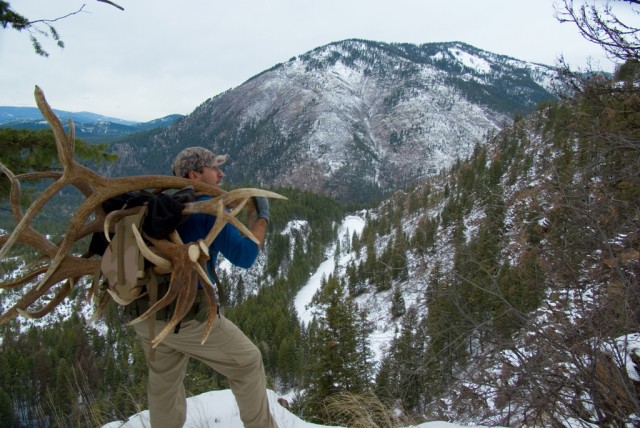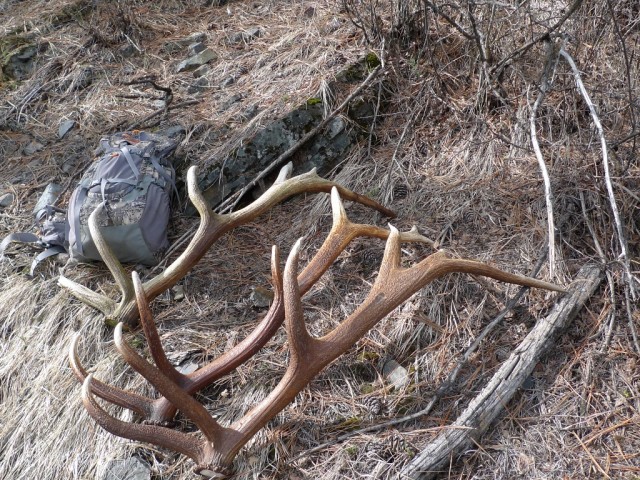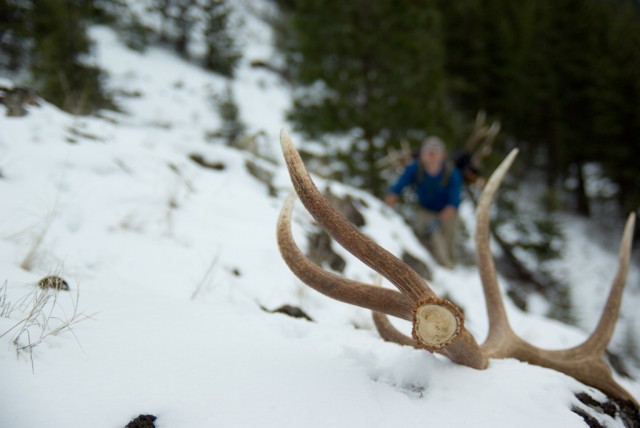My Best Day of Shed Hunting
 Nothing Right…
Nothing Right…
After sitting for a day and a half in a stuffy hotel conference room with fellow bowhunters, my impatience was surfacing. It wasn’t the company or the topics of the weekend; it was an eagerness to stomp around in the hills and enjoy the spring weather.
The evening before Montana’s annual state bowhunters convention I glassed a few obscure pockets of winter range for elk. With a low density of elk in my area, spotting a solitary bull wasn’t out of the ordinary. What was exciting was he was a big-bodied, mature, pot-bellied bull; and he was bald.
I knew with the weather warming and the snowline climbing, he would leave the area quickly and somewhere in the tangled brush would be his antlers. As I listened to the last presentation of the weekend my mind wandered continually to my next future shed hunting day.
A few days later I was fighting my way through waist deep blow-down and brush. Stumbling upon a churned-dirt elk trail, I scanned my surroundings for an antler tip or glint of a smooth beam. Five minutes up the trail I spotted a left side of a medium six point mostly hidden behind a log.
 Casting back and forth I ascended the ridge stopping to glass into thickets in side draws. An hour later I crested a small timbered bench that reeked of elk urine. Old beds indicated that elk had been here most of the winter. As I scanned the bench I saw tines gleaming in the sun to my left. Thinking I found the match to the first, I pulled it out of the brush to discover it too was a left side.
Casting back and forth I ascended the ridge stopping to glass into thickets in side draws. An hour later I crested a small timbered bench that reeked of elk urine. Old beds indicated that elk had been here most of the winter. As I scanned the bench I saw tines gleaming in the sun to my left. Thinking I found the match to the first, I pulled it out of the brush to discover it too was a left side.
As a heavy seven point from a 340 class bull I wasn’t going to complain. Wanting to find the matches to both antlers I combed the rest of the small ridge with vigor. Without a match, I traversed over to a smaller neighboring ridge and worked my way down the mountain.
Halfway down, I stopped on a sunlit rock outcrop for a snack. Carefully glassing the brush below, I spotted white tines jutting towards me. Approaching it I realized it is yet another left side. With evening coming on and a blow-down patch to navigate I decided head for home. The matches would have to come another day.
Antler Obsessed or Outdoor Infatuated?
Over the years I’ve been asked numerous times what has been my best day of shed hunting. “Best” is a broad description. Was it the outing where the most antlers were found or perhaps a day when a large set was found? What about a day out with an old friend or the first spring-like day after a long winter? When you really think about it, “best” is tough to define. As of late the best days are every one of the days I am privileged to get out. At that moment there is nothing else I would rather be doing.
A memorable trip can have many definitions. Common themes include unanticipated finds with major doses of physical suffering thrown in. I learned the art of shed hunting in some of Montana’s premier elk winter range 20 years ago. It was a popular pastime, but not to the extent it is today. There was a lot of competition but antlers were plentiful.
 I learned that if I hiked far enough; where most people were not willing to venture, success would happen. That is where the suffering comes in. Most days would start with me strapping snowshoes, extra clothing and food and water to my pack frame at 6:00 a.m. After gaining 3-4 thousand feet I would glass openings, hike trails and ease through bedding areas. As darkness approached I would find a fast and efficient route back to the valley floor.
I learned that if I hiked far enough; where most people were not willing to venture, success would happen. That is where the suffering comes in. Most days would start with me strapping snowshoes, extra clothing and food and water to my pack frame at 6:00 a.m. After gaining 3-4 thousand feet I would glass openings, hike trails and ease through bedding areas. As darkness approached I would find a fast and efficient route back to the valley floor.
It was hard work yet extremely rewarding. I learned countless skills that transfer over to hunting. I learned to go light and fast in the mountains. What clothing systems work and don’t work and that nutrition was key to success as well. Staying hydrated was as important as staying fueled and I perfected a system that I still use today. I learned the mountains are brutal and unforgiving. I also learned a lesson on the effects of air current back-eddies as I relieved myself in a 60 mph wind. Thank god for waterproof shells!
Following elk trails in the snow taught me animal behavior, biology, and food preferences. Stumbling through icy bedding areas showed me how and where elk prefer to relax. I learned when I was close to elk in thick timber by using my sense of smell; a lesson which later on helped me kill silent bulls in archery season.
The knowledge and skills gained were the real reward. As was the fitness and mental toughness I obtained from the experiences. At the time I thought it was all about the shed antlers. They were just the motivating factor to get me into the mountains.
 If you are thinking of shed hunting here are a few things to keep in mind.
If you are thinking of shed hunting here are a few things to keep in mind.
- Take some time to learn about your local elk herd. Glass wintering herds from a distance to see how they utilize the terrain and cover.
- Stay in shape so you can put in an honest effort in the spring. Run, cycle or stair-climb to maintain endurance throughout the winter.
- Learn to read and age sign. Tracks, droppings, and browsed vegetation are key indicators that elk are in the area. Try to determine if it was when elk were shedding and concentrate your efforts there.
- Do not pressure or chase animals on their winter range. Remember that as hunters were are true conservationists. Our interests are best served if we are not complicit in the unnecessary death of what we hold dear. Remember that it is just a bone; don’t make it a matter of life or death for the animal.
- Educate yourself and follow the local laws and regulations. Some states have area restrictions and/or shed hunting seasons.
